Sample-return mission
 From Wikipedia the free encyclopedia
From Wikipedia the free encyclopedia
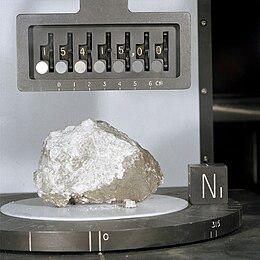
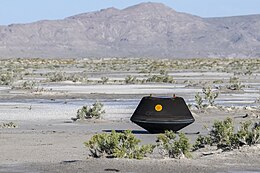
A sample-return mission is a spacecraft mission to collect and return samples from an extraterrestrial location to Earth for analysis. Sample-return missions may bring back merely atoms and molecules or a deposit of complex compounds such as loose material and rocks. These samples may be obtained in a number of ways, such as soil and rock excavation or a collector array used for capturing particles of solar wind or cometary debris. Nonetheless, concerns have been raised that the return of such samples to planet Earth may endanger Earth itself.[1]
To date, samples of Moon rock from Earth's Moon have been collected by robotic and crewed missions; the comet Wild 2 and the asteroids 25143 Itokawa, 162173 Ryugu, and 101955 Bennu have been visited by robotic spacecraft which returned samples to Earth; and samples of the solar wind have been returned by the robotic Genesis mission.
In addition to sample-return missions, samples from three identified non-terrestrial bodies have been collected by other means: samples from the Moon in the form of Lunar meteorites, samples from Mars in the form of Martian meteorites, and samples from Vesta in the form of HED meteorites.
Scientific use
[edit]
Samples available on Earth can be analyzed in laboratories, so we can further our understanding and knowledge as part of the discovery and exploration of the Solar System. Until now, many important scientific discoveries about the Solar System were made remotely with telescopes, and some Solar System bodies were visited by orbiting or even landing spacecraft with instruments capable of remote sensing or sample analysis. While such an investigation of the Solar System is technically easier than a sample-return mission, the scientific tools available on Earth to study such samples are far more advanced and diverse than those that can go on spacecraft. Further, analysis of samples on Earth allows follow up of any findings with different tools, including tools that can tell intrinsic extraterrestrial material from terrestrial contamination,[2] and those that have yet to be developed; in contrast, a spacecraft can carry only a limited set of analytic tools, and these have to be chosen and built long before launch.
Samples analyzed on Earth can be matched against findings of remote sensing for more insight into the processes that formed the Solar System. This was done, for example, with findings by the Dawn spacecraft, which visited the asteroid Vesta from 2011 to 2012 for imaging, and samples from HED meteorites (collected on Earth until then), which were compared to data gathered by Dawn.[3] These meteorites could then be identified as material ejected from the large impact crater Rheasilvia on Vesta. This allowed deducing the composition of the crust, mantle and core of Vesta. Similarly, some differences in the composition of asteroids (and, to a lesser extent, different compositions of comets) can be discerned by imaging alone. However, for a more precise inventory of the material on these different bodies, more samples will be collected and returned in the future, to match their compositions with the data gathered through telescopes and astronomical spectroscopy.
One further focus of such investigation—besides the basic composition and geologic history of the various Solar System bodies—is the presence of the building blocks of life on comets, asteroids, Mars or the moons of the gas giants. Several sample-return missions to asteroids and comets are currently in the works. More samples from asteroids and comets will help determine whether life formed in space and was carried to Earth by meteorites. Another question under investigation is whether extraterrestrial life formed on other Solar System bodies like Mars or on the moons of the gas giants, and whether life might even exist there. The result of NASA's last "Decadal Survey" was to prioritize a Mars sample-return mission, as Mars has a special importance: it is comparatively "nearby", might have harbored life in the past, and might even continue to sustain life. Jupiter's moon Europa is another important focus in the search for life in the Solar System. However, due to the distance and other constraints, Europa might not be the target of a sample-return mission in the foreseeable future.
Planetary protection
[edit]Planetary protection aims to prevent biological contamination of both the target celestial body and the Earth in the case of sample-return missions. A sample return from Mars or other location with the potential to host life is a category V mission under COSPAR, which directs to the containment of any unsterilized sample returned to Earth. This is because it is unknown what the effects such hypothetical life would be on humans or the biosphere of Earth.[4] For this reason, Carl Sagan and Joshua Lederberg argued in the 1970s that we should do sample-return missions classified as category V missions with extreme caution, and later studies by the NRC and ESF agreed.[4][5][6][7][8]
Sample-return missions
[edit]First missions
[edit]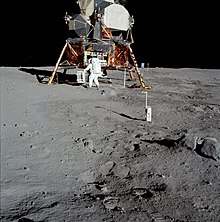
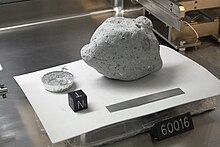
In July 1969, Apollo 11 achieved the first successful sample return from another Solar System body when it returned 22 kilograms (49 lb) of Lunar surface material. This was followed by 34 kilograms (75 lb) of material and Surveyor 3 parts from Apollo 12, 42.8 kilograms (94 lb) of material from Apollo 14, 76.7 kilograms (169 lb) of material from Apollo 15, 94.3 kilograms (208 lb) of material from Apollo 16, and 110.4 kilograms (243 lb) of material from Apollo 17.[citation needed] The Apollo program as a whole returned over 382 kg (842 lb) of lunar rocks and regolith, including lunar soil, to the Lunar Receiving Laboratory in Houston.[9][10][11] Today, 75% of the samples are stored at the Lunar Sample Laboratory Facility built in 1979.[12]
In 1970, the robotic Soviet mission Luna 16 returned 101 grams (3.6 oz) of lunar soil, followed by Luna 20's return of 55 grams (1.9 oz) in 1974, and Luna 24's return of 170 grams (6.0 oz) in 1976. Although they recovered far less than the Apollo missions, they did this fully automatically. Apart from these three successes, other attempts under the Luna programme failed. The first two missions were intended to compete with Apollo 11 and were undertaken shortly before it in June and July 1969. Luna E-8-5 No. 402 failed at start, and Luna 15 crashed on the Moon. Later, other sample-return missions failed: Kosmos 300 and Kosmos 305 in 1969, Luna E-8-5 No. 405 in 1970, Luna E-8-5M No. 412 in 1975 had unsuccessful launches, and Luna 18 in 1971 and Luna 23 in 1974 had unsuccessful landings on the Moon.[13]
In 1970, the Soviet Union planned for a 1975 first Mars sample-return mission in the Mars 5NM project. This mission was planned to use an N1 rocket, but this rocket never flew successfully and the mission evolved into the Mars 5M project, which would use a double launch with the smaller Proton rocket and an assembly at a Salyut space station. This Mars 5M mission was planned for 1979, but was canceled in 1977 due to technical problems and complexity.[14]
1990s
[edit]The Orbital Debris Collection (ODC) experiment deployed on the Mir space station for 18 months in 1996–97 used aerogel to capture particles from low Earth orbit, including both interplanetary dust and man-made particles.[15]
2000s
[edit]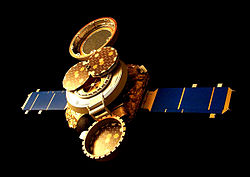
The next mission to return extraterrestrial samples was the Genesis mission, which returned solar wind samples to Earth from beyond Earth orbit in 2004. Unfortunately, the Genesis capsule failed to open its parachute while re-entering the Earth's atmosphere and crash-landed in the Utah desert. There were fears of severe contamination or even total mission loss, but scientists managed to save many of the samples. They were the first to be collected from beyond lunar orbit. Genesis used a collector array made of wafers of ultra-pure silicon, gold, sapphire, and diamond. Each different wafer was used to collect a different part of the solar wind.[16]

Genesis was followed by NASA's Stardust spacecraft, which returned comet samples to Earth on 15 January 2006. It safely passed by Comet Wild 2 and collected dust samples from the comet's coma while imaging the comet's nucleus. Stardust used a collector array made of low-density aerogel (99% of which is space), which has about 1/1000 of the density of glass. This enables the collection of cometary particles without damaging them due to high impact velocities. Particle collisions with even slightly porous solid collectors would result in the destruction of those particles and damage to the collection apparatus. During the cruise, the array collected at least seven interstellar dust particles.[17]
2010s and 2020s
[edit]In June 2010 the Japan Aerospace Exploration Agency (JAXA) Hayabusa probe returned asteroid samples to Earth after a rendezvous with (and a landing on) S-type asteroid 25143 Itokawa. In November 2010, scientists at the agency confirmed that, despite failure of the sampling device, the probe retrieved micrograms of dust from the asteroid, the first brought back to Earth in pristine condition.[18]
The Russian Fobos-Grunt was a failed sample-return mission designed to return samples from Phobos, one of the moons of Mars. It was launched on 8 November 2011, but failed to leave Earth orbit and crashed after several weeks into the southern Pacific Ocean.[19][20]

— (Full-sized image)

The Japan Aerospace Exploration Agency (JAXA) launched the improved Hayabusa2 space probe on 3 December 2014. Hayabusa2 arrived at the target near-Earth C-type asteroid 162173 Ryugu (previously designated 1999 JU3) on 27 June 2018.[21] It surveyed the asteroid for a year and a half and took samples. It left the asteroid in November 2019[22][23] and returned to Earth on 6 December 2020.[24]
The OSIRIS-REx mission was launched in September 2016 on a mission to return samples from the asteroid 101955 Bennu.[25][26] The samples are expected to enable scientists to learn more about the time before the birth of the Solar System, initial stages of planet formation, and the source of organic compounds that led to the formation of life.[27] It reached the proximity of Bennu on 3 December 2018,[28] where it began analyzing its surface for a target sample area over the next several months. It collected its sample on 20 October 2020,[29][30] and landed back on Earth again on 24 September 2023, making OSIRIS-REx the fifth successful sample return mission for mankind, in its return of samples from an extra-terrestrial body.[31][32][33][34] Shortly after the sample container was retrieved and transferred to an "airtight chamber at the Johnson Space Center in Houston, Texas", the lid on the container was opened. Scientists commented that they "found black dust and debris on the avionics deck of the OSIRIS-REx science canister" on the initial opening. Later study was planned. On 11 October 2023, the recovered capsule was opened to reveal a "first look" at the asteroid sample contents.[35][36] On 13 December 2023, further studies of the returned sample were reported and revealed organic molecules as well as unknown materials which require more study to have a better idea of their composition and makeup.[37][38] On 13 January 2024, NASA reported finally fully opening, after three months of trying, the recovered container with samples from the Bennu asteroid.[39][40] The total weight of the recovered material weighed 121.6 g (4.29 oz), over twice the mission's goal.[41]

China's CNSA launched the Chang'e 5 and 6 lunar sample-return mission on 23 November 2020 and 3 May 2024 respectively, which returned to Earth with 2 kilograms of lunar soil each on 16 December 2020 and 25 June 2024 respectively.[42] These were the first lunar sample-return missions in over 40 years.[43] The Chang'e 6 mission, which landed in the Apollo crater basin in the southern hemisphere of the lunar far side, was the first to retrieve samples from the far side of the Moon, as all previous collective lunar samples having been collected from the near side.[44]
Future missions
[edit]CNSA is planning a mission called Tianwen-2 to return samples from 469219 Kamoʻoalewa which is planned to launch in 2025.[45] CNSA plans for a Mars sample return mission by 2030.[46][47] Also, the Chinese Space Agency is designing a sample-retrieval mission from Ceres that would take place during the 2020s.[48]
JAXA is developing the MMX mission, a sample-return mission to Phobos that will be launched in 2026.[49] MMX will study both moons of Mars, but the landing and the sample collection will be on Phobos. This selection was made because of the two moons, Phobos's orbit is closer to Mars and its surface may have particles blasted from Mars. Thus the sample may contain material originating on Mars itself.[50] A propulsion module carrying the sample is expected to return to Earth in 2031.[49]
NASA and ESA have long planned a Mars Sample-Return Mission.[51] The Perseverance rover, deployed in 2020, is collecting drill core samples and stashing them on the Mars surface.[52] As of September 2023, it has gathered one atmospheric sample and 8 igneous rock samples, 11 sedimentary rock samples and a pair of regolith samples.[53] On 22 November 2023, NASA announced that it was cutting back on the Mars sample-return mission due to a shortage of funds.[54] In January 2024, the proposed NASA plan was challenged due to budget and scheduling considerations, and investigation into alternate plans begun.[55]
Russia has plans for Luna-Glob missions to return samples from the Moon by 2027 and Mars-Grunt to return samples from Mars in the late 2020s.[citation needed]
Methods of sample return
[edit]
Sample-return methods include, but are not restricted to the following:
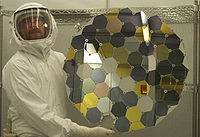
Collector array
[edit]A collector array may be used to collect millions or billions of atoms, molecules, and fine particulates by using wafers made of different elements. The molecular structure of these wafers allows the collection of various sizes of particles. Collector arrays, such as those flown on Genesis, are ultra-pure in order to ensure maximal collection efficiency, durability, and analytical distinguishability.[citation needed]
Collector arrays are useful for collecting tiny, fast-moving atoms such as those expelled by the Sun through the solar wind, but can also be used for collection of larger particles such as those found in the coma of a comet. The NASA spacecraft known as Stardust implemented this technique. However, due to the high speeds and size of the particles that make up the coma and the area nearby, a dense solid-state collector array was not viable. As a result, another means for collecting samples had to be designed to preserve the safety of the spacecraft and the samples themselves.[citation needed]
Aerogel
[edit]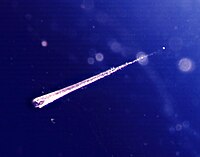
Aerogel is a silica-based porous solid with a sponge-like structure, 99.8% of whose volume is empty space. Aerogel has about 1/1000 of the density of glass. An aerogel was used in the Stardust spacecraft because the dust particles the spacecraft was to collect would have an impact speed of about 6 km/s. A collision with a dense solid at that speed could alter their chemical composition or vaporize them completely.[56]
Since the aerogel is mostly transparent, and the particles leave a carrot-shaped path once they penetrate the surface, scientists can easily find and retrieve them. Since its pores are on the nanometer scale, particles, even ones smaller than a grain of sand, do not merely pass through the aerogel completely. Instead, they slow to a stop and then are embedded within it. The Stardust spacecraft has a tennis-racket-shaped collector with aerogel fitted to it. The collector is retracted into its capsule for safe storage and delivery back to Earth. Aerogel is quite strong and easily survives both launching and space environments.[56]
Robotic excavation and return
[edit]Some of the riskiest and most difficult types of sample-return missions are those that require landing on an extraterrestrial body such as an asteroid, moon, or planet. It takes a great deal of time, money, and technical ability to even initiate such plans. It is a difficult feat that requires that everything from launch to landing to retrieval and launch back to Earth is planned out with high precision and accuracy.[citation needed]
This type of sample return, although having the most risks, is the most rewarding for planetary science. Furthermore, such missions carry a great deal of public outreach potential, which is an important attribute for space exploration when it comes to public support. The only successful robotic sample-return missions of this type have been Soviet Luna and Chinese Chang'e landers. While other missions collected materials from asteroids by various means, they did so without "landing", given their very low gravity.[citation needed]
List of missions
[edit]
Crewed missions
[edit]| Launch date | Operator | Name | Sample origin | Samples returned | Recovery date | Mission result |
|---|---|---|---|---|---|---|
| 16 July 1969 | Apollo 11 | Moon | 22 kilograms (49 lb) | 24 July 1969 | Success | |
| 14 November 1969 | Apollo 12 | Moon | 34 kilograms (75 lb) and Surveyor 3 parts[note 1][57] | 24 November 1969 | Success | |
| 11 April 1970 | Apollo 13 | Moon | — | 17 April 1970 | Failure | |
| 31 January 1971 | Apollo 14 | Moon | 43 kilograms (95 lb) | 9 February 1971 | Success | |
| 26 July 1971 | Apollo 15 | Moon | 77 kilograms (170 lb) | 7 August 1971 | Success | |
| 16 April 1972 | Apollo 16 | Moon | 95 kilograms (209 lb) | 27 April 1972 | Success | |
| 7 December 1972 | Apollo 17 | Moon | 111 kilograms (245 lb) | 19 December 1972 | Success | |
| 22 March 1996 | Earth-Orbital Debris Collection | Low Earth orbit | Particles | 6 October 1997 | Success[58] | |
| 14 April 2015 | Tanpopo mission | Low Earth orbit | Particles | February 2018[59] | Success |
Robotic missions
[edit]| Launch date | Operator | Name | Sample origin | Samples returned | Recovery date | Mission result |
|---|---|---|---|---|---|---|
| 14 June 1969 | Luna E-8-5 No. 402 | Moon | — | — | Failure | |
| 13 July 1969 | Luna 15 | Moon | — | — | Failure | |
| 23 September 1969 | Kosmos 300 | Moon | — | — | Failure | |
| 22 October 1969 | Kosmos 305 | Moon | — | — | Failure | |
| 6 February 1970[13] | Luna E-8-5 No. 405 | Moon | — | — | Failure | |
| 12 September 1970 | Luna 16 | Moon | 101 grams (3.6 oz) | 24 September 1970 | Success | |
| 2 September 1971 | Luna 18 | Moon | — | — | Failure | |
| 14 February 1972 | Luna 20 | Moon | 55 grams (1.9 oz) | 25 February 1972 | Success | |
| 2 November 1974 | Luna 23 | Moon | — | — | Failure | |
| 16 October 1975 | Luna E-8-5M No. 412 | Moon | — | — | Failure | |
| 9 August 1976 | Luna 24 | Moon | 170 grams (6.0 oz) | 22 August 1976 | Success | |
| 7 February 1999 | Stardust | 81P/Wild | Particles, weighing approx 1 gram (0.035 oz) | 15 January 2006 | Success | |
| 8 August 2001 | Genesis | Solar wind | Particles | 9 September 2004 | Partial success | |
| 9 May 2003 | Hayabusa | 25143 Itokawa | Particles, weighing less than 1 gram (0.035 oz) | 13 June 2010 | Partial success | |
| 8 November 2011 | Fobos-Grunt | Phobos | — | — | Failure | |
| 3 December 2014 | Hayabusa2 | 162173 Ryugu | 5.4 grams (0.19 oz)[60] (including gas samples) | 6 December 2020 | Success | |
| 8 September 2016 | OSIRIS-REx | 101955 Bennu | 121.6 grams (4.29 oz)[36][61] | 24 September 2023 | Success | |
| 23 November 2020 | Chang'e 5 | Moon | 1,731 grams (61.1 oz) | 16 December 2020 | Success | |
| 3 May 2024 | Chang'e 6 | Moon | 1,935.3 grams (68.27 oz)[62] | 25 June 2024 | Success | |
| 2025 | Tianwen-2 | 469219 Kamoʻoalewa | — | 2027 | Planned[63] | |
| 2026 | MMX | Phobos | — | 2031 | Planned | |
| 2028 | NASA-ESA Mars Sample Return | Mars | 500 grams (18 oz) [note 2][64] | 2033 | Ongoing[note 3] | |
| 2028 | Chandrayaan-4 | Moon | — | 2028 | Planned | |
| 2028 | Tianwen-3 | Mars | — | 2031 | Planned[65] |
See also
[edit]Notes
[edit]- ^ The Apollo 12 astronauts removed several components from Surveyor 3, including the television camera, and returned them to Earth, where they are treated as lunar samples by NASA. It returned about 10 kilograms (22 lb) of the Surveyor 3's original landing mass of 302 kilograms (666 lb) to Earth to study the effects of long term exposure. Surveyor 3 is the only probe visited by humans on another world.
- ^ The Perseverance rover is gathering samples for eventual return to Earth. As of September 2023, it has gathered one atmospheric sample and 8 igneous rock sample, 11 sedimentary rock samples and a pair of regolith samples.[53]
- ^ NASA's Mars Ascent Vehicle and the ESA's Earth Return Orbiter are still in the planning stages.
References
[edit]- ^ David, Leonard (23 June 2022). "Controversy Grows Over whether Mars Samples Endanger Earth - Planetary scientists are eager to bring Red Planet rocks, soil and even air to Earth, but critics fear the risk of contaminating our world's biosphere". Scientific American. Retrieved 5 July 2022.
- ^ Chan, Queenie Hoi Shan; Stroud, Rhonda; Martins, Zita; Yabuta, Hikaru (12 May 2020). "Concerns of Organic Contamination for Sample Return Space Missions". Space Science Reviews. 216 (4): 56. Bibcode:2020SSRv..216...56C. doi:10.1007/s11214-020-00678-7. PMC 7319412. PMID 32624626.
- ^ What did Dawn learn at Vesta? The Planetary Society.
- ^ a b Joshua Lederberg Parasites Face a Perpetual Dilemma (PDF). Volume 65, Number 2, 1999 / American Society for Microbiology News 77.
- ^ Assessment of Planetary Protection Requirements for Mars Sample Return Missions (Report). National Research Council. 2009.
- ^ Preliminary Planning for an International Mars Sample Return Mission Report of the International Mars Architecture for the Return of Samples (iMARS) Working Group 1 June 2008.
- ^ European Science Foundation – Mars Sample Return backward contamination – Strategic advice and requirements Archived 2016-06-02 at the Wayback Machine July, 2012, ISBN 978-2-918428-67-1 – see Back Planetary Protection section. (for more details of the document see abstract).
- ^ Mars Sample Return: Issues and Recommendations. Task Group on Issues in Sample Return. National Academies Press, Washington, DC (1997).
- ^ "NASA Lunar Sample Laboatory Facility". NASA Curation Lunar. NASA. 1 September 2016. Retrieved 15 February 2017.
A total of 382 kilograms of lunar material, comprising 2200 individual specimens returned from the Moon...
- ^ Orloff 2004, "Extravehicular Activity"
- ^ Chaikin, Andrew (2007). A Man On the Moon: The Voyages of the Apollo Astronauts (Third ed.). New York: Penguin Books. pp. 611–613.
- ^ Kristen Erickson (16 July 2009). Amiko Kauderer (ed.). "Rock Solid: JSC's Lunar Sample Lab Turns 30". 40th Anniversary of Apollo Program. NASA. Retrieved 29 June 2012.
- ^ a b Wade, Mark. "Luna Ye-8-5". Encyclopedia Astronautica. Archived from the original on 25 February 2002. Retrieved 27 July 2010.
- ^ Советский грунт с Марса (in Russian) Archived 8 April 2010 at the Wayback Machine
- ^ "Orbital Debris Collector (ODC)". NASA. 16 July 1999. Archived from the original on 21 May 2021. Retrieved 7 April 2021.
- ^ "A Little Glitz Goes a Long Way for NASA's Genesis". NASA. 3 September 2004. Retrieved 3 March 2023.
- ^ Westphal, A.; Stroud, R.; et al. (15 August 2014). "Evidence for interstellar origin of seven dust particles collected by the Stardust spacecraft". Science. 345 (6198): 786–91. Bibcode:2014Sci...345..786W. doi:10.1126/science.1252496. hdl:2381/32470. PMID 25124433. S2CID 206556225.
- ^ Amos, Jonathan (16 November 2010). "Japan probe collected particles from Itokawa asteroid". BBC News. Retrieved 16 November 2010.
- ^ Emily Lakdawalla (13 January 2012). "Bruce Betts: Reflections on Phobos LIFE". The Planetary Society Blog. Retrieved 17 March 2012.
- ^ Kramer, Andrew (15 January 2012). "Russia's Failed Mars Probe Crashes Into Pacific". The New York Times. Retrieved 16 January 2012.
- ^ "Japanese spacecraft reaches asteroid after three-and-a-half-year journey – Spaceflight Now". spaceflightnow.com. Retrieved 23 September 2018.
- ^ Bartels, Meghan (13 November 2019). "Farewell, Ryugu! Japan's Hayabusa2 Probe Leaves Asteroid for Journey Home". Space.com.
- ^ "Joint Statement for Cooperation in the Hayabusa2 Sample Return Mission by the Australian Space Agency and the Japan Aerospace Exploration Agency" (Press release). JAXA. 14 July 2020. Retrieved 14 July 2020.
- ^ "Hayabusa-2: Capsule with asteroid samples in 'perfect' shape". BBC News. 5 December 2020. Archived from the original on 13 July 2023.
- ^ "NASA's OSIRIS-REx Speeds Toward Asteroid Rendezvous". NASA. 9 September 2016. Retrieved 9 September 2016.
- ^ "Asteroid probe begins seven-year quest". BBC News. 9 September 2016. Retrieved 9 September 2016.
- ^ "NASA To Launch New Science Mission To Asteroid In 2016". NASA.
- ^ Chang, Kenneth (3 December 2018). "NASA's Osiris-Rex Arrives at Asteroid Bennu After a Two-Year Journey". The New York Times. Retrieved 3 December 2018.
- ^ Potter, Sean (20 October 2020). "NASA's OSIRIS-REx Spacecraft Successfully Touches Asteroid". NASA. Retrieved 21 October 2020.
- ^ "NASA's OSIRIS-REx Successfully Stows Sample of Asteroid Bennu". OSIRIS-REx Mission. Retrieved 29 November 2020.
- ^ Miller, Katrina (24 September 2023). "A NASA Spacecraft Comes Home With an Asteroid Gift for Earth - The seven-year OSIRIS-REX mission ended on Sunday [9/23/2023] with the return of regolith from the asteroid Bennu, which might hold clues about the origins of our solar system and life. + comment". The New York Times. Archived from the original on 25 September 2023. Retrieved 25 September 2023.
- ^ "Capsule Containing Asteroid Bennu Sample Has Landed". NASA. 24 September 2023.
- ^ Chang, Kenneth (10 May 2021). "Bye-Bye, Bennu: NASA Heads Back to Earth With Asteroid Stash in Tow - The OSIRIS-REX mission will spend two years cruising home with space rock samples that could unlock secrets of the early solar system". The New York Times. Retrieved 11 May 2021.
- ^ "OSIRIS-REx Factsheet" (PDF). NASA/Explorers and Heliophysics Projects Division. August 2011.
- ^ Staff (27 September 2023). "Likely asteroid debris found upon opening of returned NASA probe". Phys.org. Archived from the original on 27 September 2023. Retrieved 27 September 2023.
- ^ a b Chang, Kenneth (11 October 2023). "NASA Unveils First Glimpse of 'Scientific Treasure' Collected From Asteroid - Scientists said they got more material than expected from the Osiris-Rex mission during its seven-year journey to the asteroid Bennu". The New York Times. Archived from the original on 11 October 2023. Retrieved 12 October 2023.
- ^ Kuthunur, Sharmila (13 December 2023). "'What is that material?': Potentially hazardous asteroid Bennu stumps scientists with its odd makeup - Scientists found signs of organic molecules in the first samples of potentially hazardous asteroid Bennu, as well as a 'head scratching' material that has yet to be identified". LiveScience. Archived from the original on 14 December 2023. Retrieved 13 December 2023.
- ^ Rabie, Passant (15 December 2023). "It's Been 2 Months. Why Can't NASA Open the Asteroid Sample Container? - The space agency is having to develop new tools to crack open the canister containing bits from asteroid Bennu". Gizmodo. Archived from the original on 15 December 2023. Retrieved 16 December 2023.
- ^ MacDonald, Cheyenne (13 January 2024). "NASA finally got the stuck lid off its asteroid Bennu sample container - Thanks to some stubborn fasteners, the agency spent three months locked out of the sample OSIRIS-REx dropped off". Engadget. Archived from the original on 14 January 2024. Retrieved 13 January 2024.
- ^ Rabie, Passant (22 January 2024). "NASA Finally Opened the Asteroid Container and Holy Crap That's a Lot of Asteroid - After months of struggling to get to the bulk of the OSIRIS-REx asteroid sample, the space agency has unveiled a treasure trove of ancient rocks and dust". Gizmodo. Archived from the original on 23 January 2024. Retrieved 22 January 2024.
- ^ Rabie, Passant (15 February 2024). "We Finally Know How Much of That Asteroid OSIRIS-REx Grabbed in Space - Engineers struggled to open the sample canister for months, but it was all worth it for twice the amount of asteroid they thought they were getting". Gizmodo. Archived from the original on 16 February 2024. Retrieved 16 February 2024.
- ^ "China recovers Chang'e-5 moon samples after complex 23-day mission". SpaceNews. 16 December 2020. Retrieved 3 March 2023.
- ^ Jones, Andrew (28 November 2020). "China's Chang'e 5 enters lunar orbit for historic attempt to return moon samples". Space.com. Retrieved 29 November 2020.
- ^ Rahul Rao (25 June 2024). "China's Chang'e 6 probe will soon bring samples of the moon's far side to Earth — and scientists are getting excited". Space.com. Retrieved 26 June 2024.
- ^ "China Plans Near-Earth Asteroid Smash-and-Grab". IEEE Spectrum. 10 August 2021. Retrieved 4 November 2021.
- ^ English.news.cn (10 October 2012). "China considers more Mars probes before 2030". news.xinhuanet.com. Archived from the original on 14 October 2012. Retrieved 14 October 2012.
- ^ Staff Writers Beijing (AFP) (10 October 2012). "China to collect samples from Mars by 2030: Xinhua". marsdaily.com. Retrieved 14 October 2012.
- ^ China's Deep-space Exploration to 2030 by Zou Yongliao Li Wei Ouyang Ziyuan Key Laboratory of Lunar and Deep Space Exploration, National Astronomical Observatories, Chinese Academy of Sciences, Beijing.
- ^ a b "Japan to Delay Mars Moon Exploration by 2 Years to 2026". Yomiuri Shimbun. 6 December 2023. Retrieved 26 December 2023.
- ^ 火星衛星の砂回収へ JAXA「フォボス」に探査機. Nikkei (in Japanese). 22 September 2017. Retrieved 20 July 2018.
- ^ Chang, Kenneth (28 July 2020). "Bringing Mars Rocks to Earth: Our Greatest Interplanetary Circus Act - NASA and the European Space Agency plan to toss rocks from one spacecraft to another before the samples finally land on Earth in 2031". The New York Times. Retrieved 28 July 2020.
- ^ Voosen, Paul (25 June 2020). "NASA's new rover will collect martian rocks—and clues to planet's ancient climate". Science. American Association for the Advancement of Science. doi:10.1126/science.abd5006. Retrieved 12 October 2020.
- ^ a b mars.nasa.gov (26 August 2021). "NASA's Perseverance Plans Next Sample Attempt". NASA’s Mars Exploration Program. Retrieved 27 August 2021.
- ^ Berg, Matt (22 November 2023). "Lawmakers 'mystified' after NASA scales back Mars collection program - The space agency's cut could "cost hundreds of jobs and a decade of lost science," the bipartisan group says". Politico. Archived from the original on 22 November 2023. Retrieved 25 November 2023.
- ^ David, Leopnard (15 January 2024). "NASA's troubled Mars sample-return mission has scientists seeing red - Projected multibillion-dollar overruns have some calling the agency's plan a 'dumpster fire.'". Space.com. Archived from the original on 16 January 2024. Retrieved 16 January 2024.
- ^ a b "Stardust - NASA's Comet Sample Return Mission: Aerogel". solarsystem.nasa.gov. Retrieved 16 August 2023.
- ^ "Surveyor 2 parts brought by Apollo 12". www.collectspace.com.
- ^ "Mir Orbital Debris Collector Data Analyzed". Spacedaily.com. Retrieved 8 July 2018.
- ^ "NASA - Astrobiology Exposure and Micrometeoroid Capture Experiments". www.nasagov.com.
- ^ "小惑星探査機「はやぶさ2」が採取した小惑星Ryugu(リュウグウ)サンプルは約5.4グラム" (in Japanese). 18 December 2020. Retrieved 18 December 2020.
- ^ "NASA Announces OSIRIS-REx Bulk Sample Mass – OSIRIS-REx Mission". blogs.nasa.gov. 15 February 2024. Retrieved 15 February 2024.
- ^ "新华社权威快报丨嫦娥六号带回世界首份月背样品1935.3克" (in Simplified Chinese). 新华网. 28 June 2024. Retrieved 28 June 2024.
- ^ "China to launch Tianwen 2 asteroid-sampling mission in 2025". Space.com. 18 May 2022. Archived from the original on 5 June 2023.
- ^ "Screen shot - MAV Ascent Profile". NASA. 2 June 2022. Retrieved 30 November 2022.
- ^ Jones, Andrew (20 June 2022). "China aims to bring Mars samples to Earth 2 years before NASA, ESA mission". SpaceNews. Retrieved 4 July 2022.
External links
[edit]- The Lunar Sample Compendium by NASA
- Stardust Sample Catalog Database by NASA
- Genesis Solar Wind Samples Catalog by NASA
- Hayabusa Samples by NASA
- Mars Exploration: Sample Returns Jet Propulsion Laboratory Mars Exploration Program on sample return missions.
- Stardust Homepage Jet Propulsion Laboratory Stardust mission website.
- Genesis Mission Homepage Jet Propulsion Laboratory Genesis mission website.
- Stardust: Aerogel Stardust website on aerogel technology.
- JAXA Hayabusa JAXA Hayabusa project update.
- Evaluating the Biological Potential in Samples Returned from Planetary Satellites and Small Solar System Bodies The National Academies, Space Science Board 1998